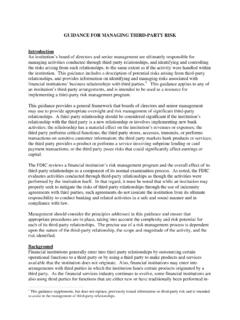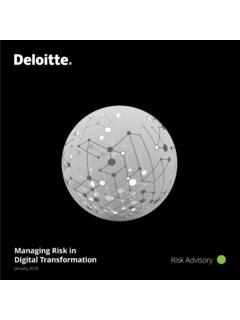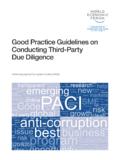Transcription of A guide to third party risk management - Grant Thornton UK …
1 A guide to third party risk managementDelivering effective risk management and assurance over your third party relationshipsWhy is third party risk management an industry priority? 3 Understanding third party relationships 4 How to mitigate the associated risks 5 Creating a risk management framework 6 Assessing security risks 8 What if there is a breach? 10 Checking that controls are working effectively 11 How we can help 12 ContentsThird party risk management and assurance services 3 Why is third party risk management an industry priority?The increased reliance on third parties may improve performance and create efficiencies across many departments, from operations to finance to HR. However, it is important to note firms who outsource business processes still own the associated operational risks and, where relevant, retain regulatory responsibility for that outsourced the reliance on third party relationships, a recent survey by Thomson Reuters found that participating global organisations conducted due diligence on just 62% of their third parties, suppliers and distributors.
2 Additionally, 61% did not know the extent to which their third parties outsourced their work, and just 36% monitored the associated risks on an ongoing many organisations may not be taking the risks seriously, regulatory and legislative bodies are. In 2015, the PRA issued a fine of over 1 million for a firm who failed to adequately oversee their third party arrangements. Although it was viewed as a high fine at the time, an increasingly complex regulatory landscape may lead to higher fines and serious punitive measures in the party relationships are already monitored through legislation around Anti-Money Laundering, Anti-Bribery and Corruption, the Sarbanes-Oxley Act and the Financial Instruments and Exchange Act; but the introduction of the EU General Data Protection Regulation (GDPR) and the Senior Managers and Certification Regime (SM&CR) bring additional governance and conduct in the UK increasingly rely on third parties to support their core activities, and in tough market conditions outsourcing can help businesses gain a competitive edge.
3 While the use of third parties can offer a range of benefits, increasingly complex supply chains bring additional risk and the need to effectively manage these relationships has never been demonstrate this in real terms, a high profile telecoms data breach (due to a cyber-attack on a third party ), resulted in a fine of 400,000 from the Information Commissioner s Office (ICO). However, under the GDPR a fine could have been much higher up to an equivalent to 4% of their annual turnover, which for this organisation would have been 59 million. Similarly, the SM&CR allows some management activities to be outsourced, but the regulatory responsibility for that activity remains with the relevant Senior Manager and they are personally accountable for it. Any issue that could have been addressed through a reasonable steps assessment by the regulators may result in fines, remuneration clawback or even a prison should be able to demonstrate to their clients and regulators that they have an adequate framework in place to control and minimise risk from their third party relationships.
4 Failure to do so may result in regulatory censure, fines and loss of confidence amongst partners and JoshiManaging Director4 third party risk management and assurance servicesUnderstanding third party relationshipsWays in which service providers can work with user organisationsUser organisations can work with service providers in several ways to provide their stakeholders with third party risk assurance: Using a strong contractual and legal framework Having a systematic risk assessment and monitoring process, and a proportionate level of control over third parties Agreeing detailed service level agreements Using internal auditors to test the effectiveness of the outsourced control environment Using a system to effectively oversee the third party risk management lifecycle, from pre-selection and due diligence, through to the end of the contract Obtaining a service auditor report from the outsourced service provider Completing an independent review of compliance with security, operational risk and privacy requirements Undertaking regular assessment over third party services in a risk based mannerThere are risks involved when collaborating with any third party .
5 However, some activities carry a higher risk, are more prone to attack or offer a greater potential for fraud than others. With the rise of cloud computing and outsourced IT operations and processes, cyber security is a key area of risk within third party relationships. Organisations should also consider their contractual arrangements and due diligence third partiesCloud servicesInvestment management and administrationEverything as a Service (XaaS) including software, infrastructure and platform as a serviceWebsite management and recovery servicesShared service centresPayment servicesClients (from a due diligence, Know Your Customer and Anti-Money Laundering perspective)Other in-group entitiesWhat are third party relationships? third parties include clients, those in the supply chain or an outsourced service provider. Outsourced services may be delivered through an external organisation, or through another entity within the same group. Due to new requirements around ring-fencing and operational continuity, large banking groups are typically establishing global service companies of this nature to centralise shared services, which may then be accessed by all entities across the party risk management and assurance services 5 third party operational risk reviews and establishing a third party risk framework Effective management of third party activities helps to minimise a company s risk exposure through its service providers Establish a framework to.
6 Increase process efficiency Provide greater risk based coverage Deliver more consistent ongoing monitoring procedures of critical third party relationshipsThird party security assessments third party IT assessments help to identify the risk, and possible impact, of any information loss through third party vendors Assess controls over powerful user accounts Assess third party security arrangements Undertake remote or onsite due diligence over third party services Undertake security assessments including: User access management Malware management System and network vulnerabilitiesService auditor reports Help to identify improvement opportunities and undertake various third party audits of outsourced projects and operational contracts Produce reports aligned to established frameworks, such as ISAE 3402, AAF or SOC reports Produce tailored third party assurance reports focusing on key areas of riskHow to mitigate the associated risksEffective third party risk management consists of three key components, as outlined below.
7 Organisations should establish an effective control framework, undertake adequate security assessments and offer assurance to senior management and other stakeholders through service auditor third party risk management and assurance servicesWith regulatory responsibility still falling to the user organisation, outsourcing raises the organisation s risk exposure on an ongoing basis and demonstrates the need for a robust third party risk management framework. Designing a framework that is fit for purpose can pose a significant challenge, particularly for organisations with a global footprint who work across a number of regulatory party operational risks reviewsThird party operational risk reviews assess an organisation s current state and help to identify gaps in the third party risk management framework. Typical issues faced by organisations include:The assessment of third party risks across the financial services industry is inconsistent, costly, time consuming and often inaccurate.
8 With no industry standard in place, firms define, measure and evaluate third party risk differently. Similarly, third party organisations are subject to multiple assessments from different user organisations to review their control environments. Not only does this create duplication of effort for third party organisations, but it is also a risk management frameworkMany organisations are using third parties to provide functions that were previously deemed to be core activities. While this can be a cost effective and efficient strategy, it can also add a considerable degree of complexity to the design and implementation of the risk and controls framework. In addition, regulatory requirements from the OCC, FCA/PRA and other international regulators can be challenging. Absence of a third party risk assessment framework to enable effective categorisation and management of suppliersPoorly established system functional requirements leading to the non-delivery of a service contractInadequately worded service provision or contractual obligationsUndefined SLAs for systems which are not adequately tested prior to going liveOngoing service provisions where target service levels are not monitored or even measuredInadequate and untested arrangements for continuity of servicesLack of contingency plans for the catastrophic failure of the third party or the services that they provideIneffective risk management of action or remediation plans for the third party servicesWe were engaged to conduct third party risk management reviews for a leading European bank to provide assurance over critical IT services.
9 The reviews revealed that the service provider was failing to maintain an effective service regime and comply with its service obligations. Our team were able to subsequently help the client with the design and methodology of an appropriate third party risk management programme, to offer more effective oversight over all of its critical suppliers and third studyThird party risk management and assurance services 7 Mitigating third party risksEstablishing an effective third party risk management frameworkThe findings from a third party risk review can form the foundation for an effective risk management framework. Organisations should consider third party risk in the context of their specific business activities and operational processes. The diagram below demonstrates a comprehensive approach to addressing third party risk management :Key considerationsWhen designing their third party frameworks, organisations should consider the following: Appropriate selection of third parties Onboarding criteria Terms and conditions Fourth party considerations Oversight arrangements including reporting and metrics Resilience and contingency planning in the event of the failure of a third party Offboarding to enable a smooth transition of services Post relationship management to include any residual operational risksPlanning/risk identification Develop a plan that outlines the company s strategy with regards to its third parties.
10 Identify the inherent risks of the services and detail how the company will select, assess and oversee its third partiesDue diligence and third party selection Perform adequate due diligence to identify potential risks before signing the contract. Understand the controls required and the risks posed to the organisationTermination Develop a plan to transition the activities to another third party , bring activities in house or discontinue activities once the contract is terminated Contract negotiation Negotiate written contracts to define the expectations and responsibilities of third parties, ensuring enforceability, limits of liability and performance oversightOngoing monitoring Conduct on-going monitoring of the third party relationships, focusing more attention on those parties who may pose a higher risk. Incorporate on-site reviews and audits as necessary 0102030405 Independent reviewsConduct independent reviews of third party risk management processes, to offer assurance over how risks are identified and mitigated, in accordance with the agreed strategy, policies and proceduresDocumentation and reportingMaintain proper documentation and reporting to facilitate oversight, accountability, monitoring and risk managementOversight and accountabilityAssign clear roles and responsibilities for overseeing and managing third party relationships.









